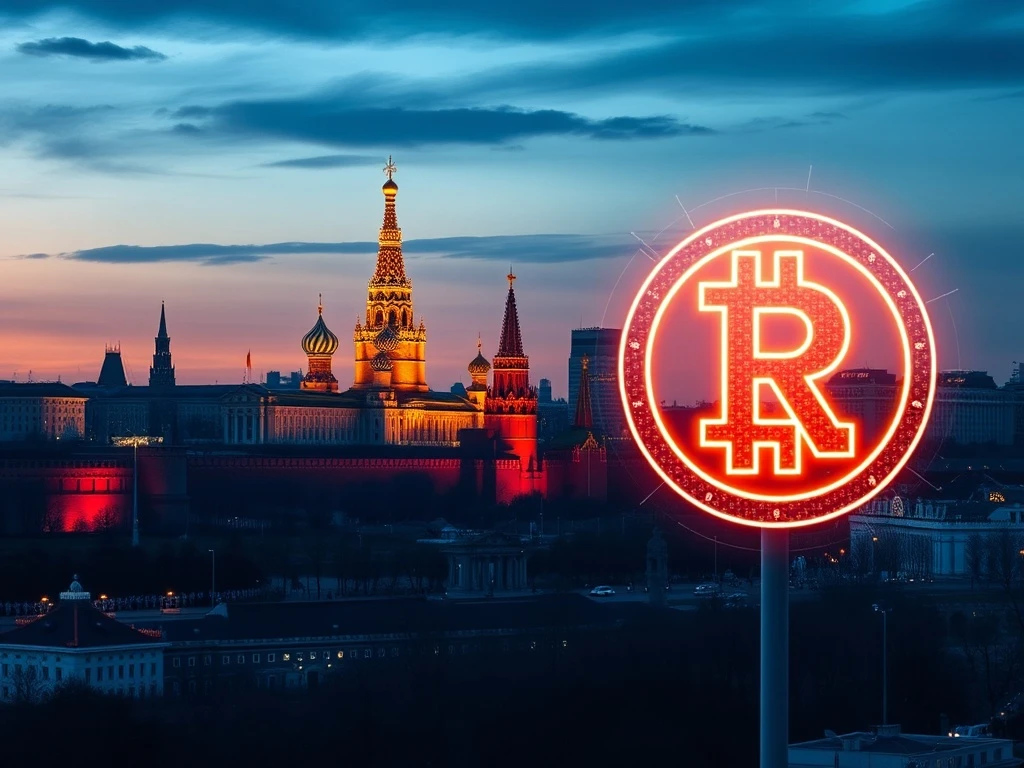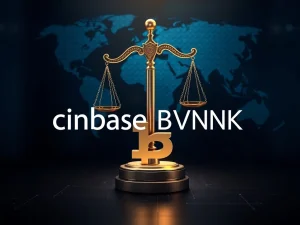Russia’s Monumental 2025 Crypto Crackdown: Accelerating the Digital Ruble Revolution

Get ready for a seismic shift in the global crypto landscape! Russia is poised to enact a comprehensive set of Russia crypto regulations in 2025, fundamentally altering how digital assets are used and accessed within the nation. This isn’t just another set of rules; it’s a strategic move designed to halt retail cryptocurrency use and dramatically accelerate the adoption of Russia’s state-backed Digital Ruble. If you’ve been following the crypto market, this development from a major global player demands your attention.
Understanding the New Russian Crypto Laws: What’s Changing?
Effective in 2025, Russia’s new regulatory framework for cryptocurrencies is a bold step towards centralized control. Spearheaded by the Central Bank of Russia and the Ministry of Finance, these reforms are extensive, aiming to manage risks and strengthen accountability. Here’s a breakdown of the key changes:
-
Retail Transaction Ban: The most significant change is the prohibition of cryptocurrencies for everyday transactions. This effectively implements a broad retail crypto ban Russia, limiting participation for individual citizens.
-
Liquidity and Access Restrictions: The new measures are designed to reduce liquidity on exchanges and restrict general access to crypto investments. Participation will primarily be reserved for qualified institutional investors, shifting the landscape of crypto investment Russia significantly.
-
Account Freezing Authority: Financial institutions are now empowered to freeze accounts linked to crypto activities, enhancing regulatory oversight and curbing informal economic activities.
-
Mining Scrutiny: The cryptocurrency mining industry also faces heightened scrutiny, with potential penalties for non-compliant operations. This aims to bring the energy-intensive activity under state control.
-
Strategic Shift: As Elvira Nabiullina, Governor of the Bank of Russia, stated, “The Bank of Russia is ready to allow investments in cryptocurrencies within the Russian Federation, but only for individual market participants.” This implies a controlled environment where the state dictates who can participate and how.
The Digital Ruble: Russia’s Answer to Decentralized Crypto?
The regulatory overhaul is intrinsically linked to Russia’s long-term objective of launching its own state-backed Digital Ruble by 2026. This central bank digital currency (CBDC) aims to reconfigure the nation’s financial landscape, reducing reliance on traditional, decentralized crypto assets. Here’s how it fits into the bigger picture:
-
Financial Reconfiguration: The digital ruble is intended to streamline financial transactions, enhance payment system efficiency, and reduce the economy’s reliance on cash and foreign currencies.
-
Historical Context: While earlier attempts like the 2019 Digital Financial Assets Act sought to regulate crypto, enforcement challenges persisted. The 2025 reforms aim to address these gaps by tightening transaction controls and expanding monitoring capabilities, paving the way for the digital ruble.
-
Accelerated Development: The restrictions on private cryptocurrencies are expected to accelerate the digital ruble’s infrastructure development, with technological advancements supporting its integration into the formal economy by 2026.
-
Controlled Innovation: The Central Bank emphasizes that these regulations balance innovation with financial stability, ensuring that high-risk crypto activities remain within a controlled framework. This means innovation might shift towards blockchain applications under state supervision.
Impact of the Retail Crypto Ban Russia: Who Gets Affected?
The immediate and most direct impact of these stringent Russia crypto regulations will be felt by individual investors and the broader retail market. Here’s what it means:
-
Limited Access for Individuals: The ban on using cryptocurrencies for everyday transactions means individuals will find it extremely difficult, if not impossible, to engage in typical crypto activities like buying goods or services with digital assets.
-
Shift in Investment Patterns: With access limited to qualified institutional investors, the landscape for crypto investment Russia will drastically change. Individual participation will likely be driven underground or cease altogether, while larger entities will need to adapt to stricter compliance.
-
Reduced Market Liquidity: By curbing retail participation and enabling account freezes, the regulations aim to reduce the overall liquidity of cryptocurrencies on Russian exchanges, making them less attractive for speculative trading.
-
Focus on Centralized Systems: This move underscores Russia’s preference for centralized digital finance, moving away from the decentralized ethos of many cryptocurrencies.
Navigating Crypto Investment Russia: Challenges and Opportunities
While the new Russian crypto laws present significant challenges, particularly for decentralized crypto, they also hint at new opportunities within a state-controlled framework. Market analysts suggest that these restrictions could reshape Russia’s crypto ecosystem:
-
Compliance Burden: Legal entities and financial institutions involved in digital assets will face a heavier compliance burden, necessitating robust systems to monitor and report crypto-related activities.
-
State-Supervised Blockchain Innovation: The focus might shift from open, decentralized blockchain projects to those that align with state objectives, potentially fostering innovation in specific, controlled blockchain applications.
-
Alignment with Global Trends: The reforms also signal a broader effort to align with global regulatory trends, positioning Russia as a key player in the evolution of digital finance, albeit with a unique, state-centric approach.
-
Potential for Digital Ruble Integration: The acceleration of the digital ruble project could create new avenues for businesses and individuals to engage with a state-backed digital currency, potentially offering efficiencies within the formal economy.
The Future of Crypto Investment Russia: A Controlled Digital Frontier
The phased approach to these regulations underscores a cautious transition from decentralized systems to a regulated digital currency model. It’s a clear signal that Russia intends to control its digital financial future, rather than letting it be shaped by the global, often unregulated, crypto market. The long-term implications will be profound, not just for Russia, but potentially as a model for other nations contemplating similar levels of control over digital assets.
In essence, Russia’s 2025 crypto regulations mark a pivotal moment. By enacting a near-total retail crypto ban Russia and aggressively pushing the Digital Ruble, the nation is asserting centralized control over its digital financial future. While this presents significant hurdles for individual crypto enthusiasts and existing market players, it also sets the stage for a new era of state-controlled digital finance and potentially, state-approved blockchain innovation. The world will be watching closely to see how this ambitious strategy unfolds and reshapes the global crypto narrative.
Frequently Asked Questions (FAQs)
1. What are the key aspects of Russia’s 2025 crypto regulations?
The core aspects include a ban on using cryptocurrencies for everyday retail transactions, increased scrutiny on crypto mining, authorization for financial institutions to freeze crypto-linked accounts, and a general shift towards reserving crypto participation for qualified institutional investors.
2. How will the new laws impact retail crypto users in Russia?
Retail crypto users in Russia will face significant restrictions, including the inability to use cryptocurrencies for payments, reduced access to exchanges, and potential account freezes if involved in non-compliant activities. This effectively implements a broad retail crypto ban.
3. What is the Digital Ruble, and when is it expected to launch?
The Digital Ruble is Russia’s state-backed central bank digital currency (CBDC). It is expected to be fully integrated into the formal economy by 2026, aiming to streamline financial transactions and reduce reliance on traditional cryptocurrencies.
4. Will cryptocurrency mining still be allowed in Russia?
Yes, cryptocurrency mining will still be allowed, but it will face heightened scrutiny and potential penalties for non-compliant operations. The aim is to bring mining activities under stricter state control and regulation.
5. Why is Russia enacting such strict crypto regulations?
Russia is enacting these strict regulations primarily to manage financial risks, strengthen accountability, curb informal economic activities, and accelerate the adoption of its own Digital Ruble. It’s a strategic move towards centralized control over digital assets.
6. Are there any exceptions to the crypto ban for certain investors?
While a general retail crypto ban is in place for everyday transactions, the regulations indicate that investments in cryptocurrencies within Russia may be allowed for “individual market participants” – likely referring to qualified institutional investors or those operating within a highly controlled, compliant framework.







